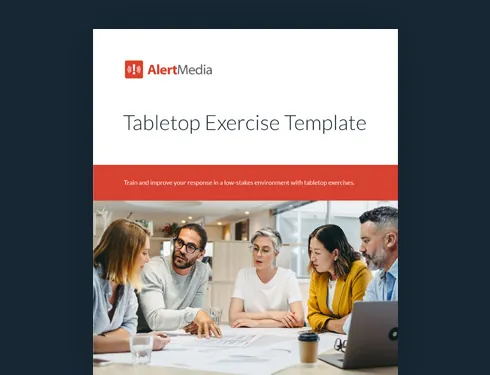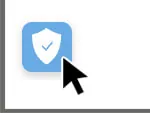
Tabletop Tests: Low-Cost, High-Impact Emergency Planning
You don’t need a massive budget to strengthen your emergency response. Tabletop tests let your team rehearse disaster scenarios, fix gaps in your plan, and build muscle memory without the high cost or disruption of a full-scale drill.

Just like any skill set, responding to an emergency takes practice. But you don’t want to wait until your third or fourth crisis to get it right. The best time to test your plan is before anything goes wrong—and that doesn’t always require a complex simulation. A tabletop test is a low-cost, high-impact way to build your team’s confidence and coordination by walking through realistic scenarios together.
Organizations of all sizes use tabletop tests to strengthen decision-making, improve communication, and uncover gaps in their response plans. These simple, discussion-based exercises are an easy and effective first step toward stronger emergency preparedness—and they can fit into just about any planning process.
Tabletop Exercise Template
What Is a Tabletop Test?
“The best time to prepare for a disaster is in a classroom, not when a disaster occurs.”Larry Robert Disaster Recovery Manager
Federal Reserve Bank of Boston
A tabletop test, also known as a tabletop exercise (TTX) or tabletop scenario, is a simulation or role-playing exercise involving key stakeholders to discuss and evaluate their plans for a hypothetical scenario or emergency situation.
During a tabletop test, participants assume individual or departmental roles and engage in facilitated discussions and decision-making processes based on the scenario.
You can perform tabletop tests for a range of situations, including a natural disaster, cyberattack, public health crisis, or terrorist incident. The purpose of the exercise is to assess an organization’s plans, procedures, and coordination mechanisms and identify strengths, weaknesses, and areas for improvement.
Why Use Tabletop Tests to Prepare for an Emergency? — 5 Benefits
Tabletop tests are one of many strategies for preparing your team to navigate an emergency. They offer a few specific benefits that make them ideal for businesses of all sizes.
Improving preparedness
Firstly, tabletop tests enhance preparedness by identifying strengths, weaknesses, and gaps in your response plans. Organizations can refine their response protocols and procedures through these simulations to ensure better readiness for real-life crises. These exercises also aid in risk identification by revealing threats that may arise during an incident. These insights improve your preparedness by allowing proactive measures to bolster security and resilience.
Strengthening critical thinking
Tabletop exercises also develop your team’s decision-making skills by simulating emergency scenarios and prompting on-the-fly thinking. This equips stakeholders with the ability to evaluate options and make informed decisions efficiently during an actual crisis.
Communication and coordination improvements are another advantage, as these exercises reveal any challenges or gaps and help you fix them before the event’s critical point.
Connecting your team members
Furthermore, tabletop tests promote team building and collaboration by bringing stakeholders together, fostering relationships, and developing a shared understanding of roles and responsibilities. This collaborative environment enhances coordination and your overall response capacity.
Initiating plan improvements
Conducting tabletop tests also facilitates identifying lessons learned and areas for improvement. Through the debriefings and analysis in the exercise, organizations can continuously refine their emergency response plans, update protocols, and incorporate best practices, thereby improving their preparedness and response capabilities over time.
Lowering stakes and costs
Tabletop tests are one of the most accessible and cost-effective ways to evaluate emergency preparedness. Unlike functional simulations or full-scale drills, tabletop testing requires minimal setup, no specialized facilities, and little to no interruption to daily operations. These exercises focus on decision-making, policies and procedures, and team coordination—without the overhead that often comes with more complex testing methods.
They’re also easier to plan and repeat. A tabletop can be run virtually or in a conference room, often within a few hours. This low investment makes them ideal for organizations with limited budgets, hybrid teams, or high operational demands that don’t allow for system downtime. Staff can safely walk through potential emergency scenarios, ask questions, and refine documentation without the pressure or risk involved in hands-on execution.
Because of their flexibility, you can use tabletop exercises more frequently than other test types. They help build confidence and keep continuity plans current without draining time or resources. When used strategically, they offer a low-cost method of execution that delivers consistent value.
Comparison Chart: Emergency Exercises
Tabletop exercise | Functional exercise (simulation) | Full-scale exercise | |
Cost | Low | Moderate | High |
Resources required | Minimal (people, documentation only) | Systems, tools, and limited tech | Full deployment of staff and equipment |
Impact on business operations | None | Low to moderate | High (may involve real disruptions) |
Risk level | None | Low | Moderate to high |
Planning time | Short | Moderate | Extensive |
Execution time | 1–3 hours | Half-day to full-day | Full-day or longer |
Focus areas | Decision-making and communication | Coordination, timing, and functional roles | Field execution, logistics, and complete plans |
Environment | Conference room or virtual | Control room or operations center | Real-world or staged field locations |
Documentation output | Scenarios, lessons learned, and action items | Functional testing results and gaps | Complete response data and post-incident report |
Best for | Reviewing plans and training new staff | Testing systems and coordination | Validating full-scale readiness |
What kind of tabletop tests can you run?
The most common types of tabletop tests vary by industry, organization, and specific objectives. Here are some widely used tabletop test formats:
- Emergency response tabletop exercise—Simulate various crisis scenarios, allowing your participants to discuss and make decisions based on their roles and responsibilities.
- Cybersecurity tabletop exercise—Simulate cyber threats and incidents to assess your readiness and response capabilities in the event of a cyberattack, such as ransomware.
- Business continuity tabletop exercise—Simulate your ability to maintain critical business operations during disruptions, such as natural disasters or infrastructure failures; facilitators evaluate business continuity plans, communication strategies, and overall decision-making processes.
- Pandemic or public health tabletop exercise—Simulate public health crises, such as pandemics or disease outbreaks, to assess your preparedness for managing health emergencies.
- Crisis communication tabletop exercise—Simulate how to effectively communicate with stakeholders, media, and the public during crises, ensuring consistent messaging and timely updates.
- Incident response tabletop exercise—Simulate your organization’s ability to respond to specific incidents, such as a chemical spill, industrial accident, or natural disaster; discuss incident response plans, decision-making processes, and coordination among different teams and stakeholders.
- Disaster recovery tabletop exercise—Simulate your organization’s recovery capabilities in an emergency management plan for a natural disaster, cyberattack, infrastructure failure, or other crisis.
It’s important to note that these are just a handful of examples. The tabletop tests you run for your business should be customized to meet your specific needs and objectives based on your industry, potential risks, and operational context.
When and Why to Tabletop Test?
The right time to run a tabletop test is before you need it. Many organizations wait until they revise a business continuity plan (BCP) or finalize an incident response plan. Still, tabletop exercises are most effective when scheduled proactively—ideally before a new risk emerges or a compliance deadline looms. Setting a regular cadence, such as semi-annually or annually, helps ensure testing stays aligned with broader risk management goals and doesn’t get pushed aside in day-to-day operations.
Trigger-based scheduling can also be effective. For example, launching a new technology platform or onboarding a major service provider may introduce fresh vulnerabilities, making it a good moment to test specific cyber threat scenarios like ransomware or phishing. Likewise, a targeted tabletop can confirm whether those changes work in practice after significant updates to disaster recovery plans or information security protocols.
Organizations don’t need to test everything at once. A smaller exercise focused on a single cybersecurity incident or a hypothetical data breach can provide meaningful insights without overburdening team members. The point is to select scenarios that reflect the organization’s size, structure, and risk exposure. Pace them to support continuous improvement rather than last-minute scrambling.
What Do Regulators, Insurers, and Auditors Want to See?
Tabletop exercises aren’t just good practice; they’re increasingly tied to regulatory expectations, insurance conditions, and audit readiness. While not always mandatory, these tests can strengthen your position across all three areas, especially when documented well and aligned with your organization’s broader continuity and risk objectives.
Regulatory requirements | Insurance implications | Audits and evidence |
|
|
|
Regulatory requirements
Some industries face clear compliance requirements around tabletop testing. For example, credit unions are expected to follow National Credit Union Administration (NCUA) guidelines, which recommend periodic exercises as part of their business continuity planning. In healthcare, the Health Insurance Portability and Accountability Act (HIPAA) doesn’t name tabletop exercises directly but requires covered entities to test contingency plans. Similarly, organizations following National Institute of Standards and Technology (NIST) guidance on information security are encouraged to simulate cyber threats as part of their preparedness efforts.
How often you run these exercises depends on the risk profile of your business. Regulators may expect annual testing for critical infrastructure, while others leave the frequency to internal policies. What’s consistent is the expectation for documentation: agendas, participant lists, discussion summaries, and any resulting action items should be stored so that legal and compliance teams can easily access if needed.
Insurance implications
Tabletop tests are also gaining importance in cyber insurance. Some cyber insurance providers view them as a sign of maturity in your incident response plan, particularly if scenarios include ransomware, phishing, or broader cyber threats. While they may not be required for all policies, demonstrating that your organization has conducted simulations can support underwriting discussions and help establish a stronger security posture.
Insurers may request evidence that continuity plans were tested and followed in the case of a claim, especially one involving a data breach. That evidence could include notes from the exercise, specific risk management actions taken, and digital records that show team members understood and rehearsed their roles.
Audits and evidence
Auditors want to see more than a line item that says “tabletop test complete.” Effective audits rely on thorough, well-organized documentation: the exercise scenario, clear objectives, communication strategies, and a follow-up plan with assigned responsibilities. Whether the audit is internal, part of a vendor assessment, or tied to regulatory oversight, missing or incomplete documentation can raise red flags.
An indispensable part of that documentation is the after-action report. Created after every exercise, this report summarizes what happened, identifies strengths and weaknesses, and outlines specific action items for improvement. It records what was learned and how your organization plans to close any gaps, making it essential for audit readiness, regulatory compliance, and continuous improvement.
One of the most overlooked elements is how those action items are tracked and integrated into daily operations. Surface-level findings aren’t enough—auditors want to see that lessons learned lead to real changes. Treating your tabletop documentation, including the after-action report, as part of your audit trail helps ensure you’re ready when questions arise.
Alignment With Industry Standards and Frameworks
Tabletop exercises are not just a best practice but a cornerstone of preparedness recognized by leading industry standards. For example, the NIST Cybersecurity Framework (CSF) explicitly recommends conducting regular incident response testing (Function: Respond, Category: RS.IM) to improve an organization’s ability to detect, respond to, and recover from cyber incidents. Tabletop tests offer a structured, repeatable way to meet that recommendation.
Similarly, ISO/IEC 27001 emphasizes the importance of testing and reviewing information security incident response plans. Tabletop tests help demonstrate that your organization isn’t just documenting a plan—it’s validating its effectiveness.
By aligning with these frameworks, tabletop testing strengthens internal preparedness and provides external validation that your organization follows globally recognized standards for risk management and cybersecurity. That alignment can be especially valuable when communicating with stakeholders, negotiating insurance, or preparing for audits and certifications.
Tabletop Testing in Frameworks at a Glance | ||
Framework | Relevant section | Emphasis |
| NIST CSF | Respond / RS.IM | Test incident response capability |
| ISO 27001 | A.16.15 | Evaluate and improve response to security incidents |
| CIS Controls | Safeguard 17.4 | Test incident response plans at least annually |
Getting the Most from Your Tabletop Tests
Tabletop tests are most effective when grounded in your actual operational and compliance needs, not just when you are running them to check a box. Facilitators should understand what outcomes matter to regulators, insurers, and auditors, and teams should build in time to document what happened and what needs to change. These exercises aren’t one-offs; they keep continuity plans active and relevant.
Many organizations fall short by setting vague objectives or skipping documentation. Others gather useful feedback but never translate it into action. Audit results, insurance reviews, and even internal debriefs can all help create stronger, more realistic scenarios next time.
Need help structuring your next test? Download our free tabletop test template. It walks you through planning, facilitation, and follow-up so your team stays aligned—and your documentation is ready when it counts.






